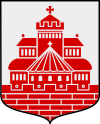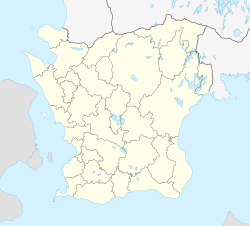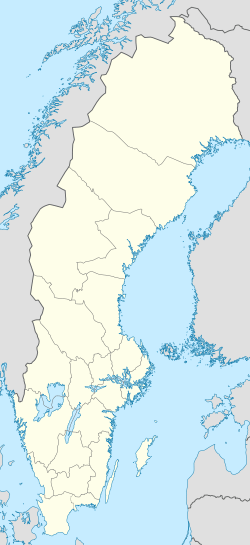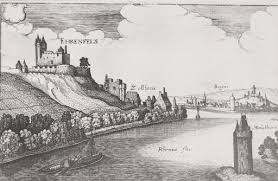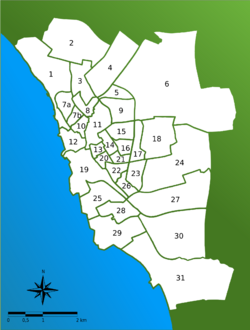Helsingborg facts for kids
Quick facts for kids
Helsingborg
|
||
|---|---|---|
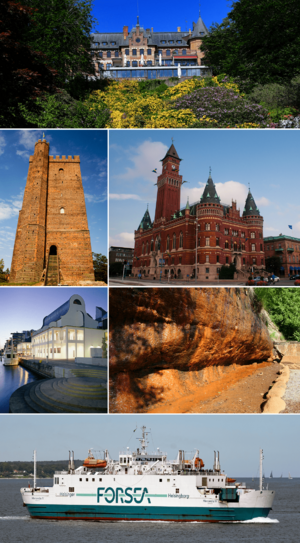
Top: Sofiero Palace, Second left: Kärnan, Second right: Rådhuset (Helsingborg City Hall), Third left: Dunker Culture House, Third right: Ramlösa mineral water source site, Bottom: A cruise terminal in Helsingborg Bredgatan Port
|
||
|
||
| Nickname(s):
Pearl of the strait
|
||
| Country | ||
| Province | ||
| County | Skåne County | |
| Municipality | Helsingborg Municipality | |
| Charter | 1085 | |
| Area | ||
| • Total | 38.41 km2 (14.83 sq mi) | |
| Population
(2020-12-31)
|
||
| • Total | 113,816 | |
| • Density | 2,529/km2 (6,550/sq mi) | |
| Time zone | UTC+1 (CET) | |
| • Summer (DST) | UTC+2 (CEST) | |
| Postal code |
25x xxx
|
|
| Area code(s) | (+46) 42 | |
| Website | www.helsingborg.se | |
Helsingborg is a city in Sweden. It is located in Scania, a region in southern Sweden. Helsingborg is the second-largest city in Scania, after Malmö. It is also the ninth-largest city in all of Sweden. In 2024, about 151,404 people lived here.
Helsingborg is very close to Denmark. The Danish city of Helsingør is only about 4 kilometers (2.5 miles) away across the Øresund strait. You can easily see it from Helsingborg.
This historic city has many old buildings. You'll find ancient stone churches and a 600-year-old medieval fortress called Kärnan in the city center. There are also many modern buildings. The streets range from wide roads to small, narrow alleys. Kullagatan, the main shopping street, was the first street in Sweden made just for people walking.
Contents
History of Helsingborg
Helsingborg is one of the oldest cities in what is now Sweden. People have lived here permanently since May 21, 1085. The city's location was very important because it's at the narrowest part of the Øresund strait. Back then, Denmark controlled both sides of this water.
Taxes and Wars
From 1429, a king named Eric of Pomerania started charging a tax called the Sound Dues. This tax was on all trading ships that passed through the strait between Helsingør and Helsingborg. This tax was a major source of money for the Danish kings. Fishermen and other crossing traffic did not have to pay it.
After a war between Denmark and Sweden (1657–1658), Denmark had to give up its land on the southern Scandinavian peninsula. Helsingborg then became part of Sweden. King Charles X Gustav of Sweden arrived in Helsingborg on March 5, 1658. He came to take control of the land. At that time, the town had only about 1,000 people.
Being on a border that often had conflicts caused problems for Helsingborg. Denmark tried to take back the land twice but couldn't keep it. The last time Denmark tried was in 1710. About 14,000 Danish soldiers landed near Helsingborg. The Battle of Helsingborg happened on March 10, just outside the city. The city was badly damaged and took a long time to recover. By 1770, only 1,321 people lived there.
On October 20, 1811, Jean-Baptiste Bernadotte stepped onto Swedish soil for the first time in Helsingborg. He was a French general who was chosen to be the next king of Sweden.
Growth and Modernization
From the mid-1800s, Helsingborg grew very quickly. Its population went from 4,000 in 1850 to 56,000 in 1930. This growth was due to new factories and industries. In 1892, a train ferry started running between Helsingborg and Helsingør in Denmark. A tramway (streetcar) system opened in 1903 but closed in 1967.
In 1906, the spelling of many Swedish place names was updated. In 1912, the city's name became Hälsingborg. But in 1971, it changed back to Helsingborg when the city joined with other areas to form a larger municipality.
World War II Rescue
During World War II, Helsingborg played a very important role in saving Denmark's Jewish population. In October 1943, Adolf Hitler ordered that all Danish Jews be arrested and sent to concentration camps.
A German official named Georg Ferdinand Duckwitz found out about the order. He quickly told Danish leaders. The Danish people then created a secret network to help the Jews. They used the name "Elsinore Sewing Club" as a code. People hid Jewish families in their homes, farms, and churches. They then helped them get onto fishing boats and other small boats. These boats crossed the Øresund to safety in Sweden, often landing in Helsingborg. In just three nights, over 7,200 Jews and 680 non-Jews were smuggled across the strait to safety in Sweden. Helsingborg was one of the main places they arrived.
Climate
Helsingborg has an oceanic climate, which means it has mild winters and warm summers. Winters are very mild for a city so far north. January and February usually have average temperatures just above freezing. Summers are warm and last a long time compared to most of Sweden. Summer arrives earlier and autumn later here than in almost all other parts of Sweden.
Helsingborg has also seen some tornadoes.
- On August 8, 1947, a tornado hit the Ramlösa area. It damaged a farm, greenhouses, and a shed.
- On August 16, 2007, a tornado hit downtown Helsingborg. It damaged a school and broke trees.
- On June 22, 2014, a Waterspout (a tornado over water) was seen outside Helsingborg.
- On August 27, 2018, a tornado hit the Eskilsminne area, causing minor damage to some roofs.
| Climate data for Helsingborg (2002–2022 averages), extremes since 1948 | |||||||||||||
|---|---|---|---|---|---|---|---|---|---|---|---|---|---|
| Month | Jan | Feb | Mar | Apr | May | Jun | Jul | Aug | Sep | Oct | Nov | Dec | Year |
| Record high °C (°F) | 11.0 (51.8) |
15.3 (59.5) |
18.0 (64.4) |
26.0 (78.8) |
28.1 (82.6) |
30.9 (87.6) |
33.2 (91.8) |
32.4 (90.3) |
31.1 (88.0) |
22.5 (72.5) |
16.6 (61.9) |
12.0 (53.6) |
33.2 (91.8) |
| Mean maximum °C (°F) | 8.0 (46.4) |
8.6 (47.5) |
14.0 (57.2) |
19.3 (66.7) |
24.7 (76.5) |
27.5 (81.5) |
29.4 (84.9) |
28.4 (83.1) |
23.7 (74.7) |
17.5 (63.5) |
12.5 (54.5) |
9.0 (48.2) |
30.1 (86.2) |
| Mean daily maximum °C (°F) | 3.0 (37.4) |
3.3 (37.9) |
6.9 (44.4) |
12.5 (54.5) |
17.1 (62.8) |
20.7 (69.3) |
22.8 (73.0) |
22.3 (72.1) |
18.3 (64.9) |
12.6 (54.7) |
7.9 (46.2) |
4.4 (39.9) |
12.7 (54.8) |
| Daily mean °C (°F) | 0.8 (33.4) |
0.5 (32.9) |
3.4 (38.1) |
7.9 (46.2) |
13.3 (55.9) |
16.0 (60.8) |
18.1 (64.6) |
17.7 (63.9) |
14.4 (57.9) |
9.6 (49.3) |
5.8 (42.4) |
2.4 (36.3) |
9.2 (48.5) |
| Mean daily minimum °C (°F) | −1.4 (29.5) |
−1.3 (29.7) |
−0.1 (31.8) |
3.2 (37.8) |
7.5 (45.5) |
11.2 (52.2) |
13.4 (56.1) |
13.4 (56.1) |
10.5 (50.9) |
6.5 (43.7) |
3.6 (38.5) |
0.4 (32.7) |
5.6 (42.0) |
| Mean minimum °C (°F) | −10.3 (13.5) |
−8.9 (16.0) |
−6.9 (19.6) |
−2.8 (27.0) |
1.1 (34.0) |
6.1 (43.0) |
9.0 (48.2) |
8.1 (46.6) |
4.2 (39.6) |
−1.2 (29.8) |
−4.6 (23.7) |
−7.6 (18.3) |
−12.8 (9.0) |
| Record low °C (°F) | −21.7 (−7.1) |
−20.5 (−4.9) |
−18.8 (−1.8) |
−8.7 (16.3) |
−1.5 (29.3) |
3.0 (37.4) |
4.4 (39.9) |
5.4 (41.7) |
−0.1 (31.8) |
−7.3 (18.9) |
−10.3 (13.5) |
−22.0 (−7.6) |
−22.0 (−7.6) |
| Average precipitation mm (inches) | 52.1 (2.05) |
43.8 (1.72) |
37.0 (1.46) |
27.5 (1.08) |
49.5 (1.95) |
67.2 (2.65) |
72.0 (2.83) |
87.0 (3.43) |
51.2 (2.02) |
69.8 (2.75) |
55.3 (2.18) |
60.5 (2.38) |
672.9 (26.5) |
| Source 1: SMHI Open Data | |||||||||||||
| Source 2: SMHI Monthly Data 2002–2022 | |||||||||||||
Population and Areas
As of 2020, 113,816 people live in the city of Helsingborg. The larger area, called the municipality, has 149,280 residents. Helsingborg is the second-largest city in Scania and the ninth-largest in Sweden.
The City of Helsingborg is divided into 31 smaller areas called districts.
Economy and Business
Helsingborg is an important center for trade, transportation, and business in its region. In 2001, Campus Helsingborg opened. It is a part of University of Lund and is located in old factory buildings.
Three ferry companies operate ferries that carry people and goods to and from Denmark all day and night. This route is popular with people taking day trips to Helsingør or Copenhagen. Many also enjoy the views from the ferries.
Many well-known companies have a presence in Helsingborg:
- IKEA, the famous furniture and home goods store, has its international main office here.
- Nicorette, a nicotine chewing gum, has a factory in the city.
- Ramlösa is a popular mineral water that comes from Ramlösa Brunn, a southern part of the city.
- Spectronic, a mobile phone developer, is also in Helsingborg.
- Tailor Store Sweden AB, an online custom clothing company, has its offices here.
- Zoégas, a major coffee company, has been in Helsingborg since the 1800s.
Food and Drink
The drink called espresso and tonic was first served in Helsingborg. It appeared on a menu at the Koppi Roasters coffeehouse in 2007.
Sports
Helsingborg is home to many sports clubs. Here are some of them:
- Stattena IF
- Helsingborgs IF
- FC Helsingborg
- Helsingborgs HC
- Hittarps IK
- Högaborgs BK
- Ramlösa Södra FF
- HRC Gripen
- Helsingborg MCK
- FC Drottninghög
- Eskilsminne IF
- Helsingborgs FRK
- Kullavägens BK
- Helsingborg BBK
Helsingborg also hosts a big ten-pin bowling event called the Lucky Larsen Masters. It's part of the World Bowling Tour. Olympia Bowling in Helsingborg hosted the event in 2019 and will host it again in September 2023.
Famous People from Helsingborg
Many notable people have come from Helsingborg:
- Hasse Alfredson, comedian
- Louise Hansson, World champion swimmer
- Marianne Bernadotte, former fashion model and actress
- Boel Berner, sociologist and historian
- Nick Bostrom, philosopher
- Kalle Brink, professional golfer
- Fabian Brunnström, ice hockey player
- Dieterich Buxtehude, composer and organist
- Elsa Collin, actress
- Covenant, synth band
- Darkane, metal band
- Elegant Machinery, synth band
- Pontus Farnerud, football player
- Linn Grant, professional golfer
- Louise Friberg, professional golfer
- Maja Ivarsson, lead singer of rock band The Sounds
- Joseph B. Johnson, former Governor of the U.S. State of Vermont
- Alexander Kačaniklić, football player
- Karl Kruszelnicki, scientist (Dr Karl)
- Henrik Larsson, football player
- Ann Linde, former Swedish foreign minister
- Hampus Lindholm, ice hockey player
- Johan Liiva, musician
- Andreas Lilja, ice hockey player
- Mikael Lundberg, golfer
- Mats Magnusson, football player
- Gunnar Nilsson, Formula One driver
- Roland Nilsson, football player
- Tina Nordström, chef
- Thomas Öberg, lead singer of bob hund
- Oscar Olsson, educationalist
- Anette Olzon, singer
- Lina Perned, actress
- Peps Persson, musician
- Nils Poppe, comedian
- Ruben Rausing, founder of Tetra Pak
- Eva Rydberg, comedian
- Eric Saade, musician and presenter
- Marcus Schossow, electronic DJ
- Caroline Seger, football player
- Jay Smith, singer
- Soilwork, metal band
- Kalle Svensson, football player
- Terror 2000, metal band
- Tobias Törnkvist, ice hockey player
- Tove Lo, singer-songwriter
- Velvet, singer
- Östen Warnerbring, musician
- The Wasted Penguinz, DJ duo
- Johan Wissman, athlete
Images for kids
See also
 In Spanish: Helsingborg para niños
In Spanish: Helsingborg para niños


